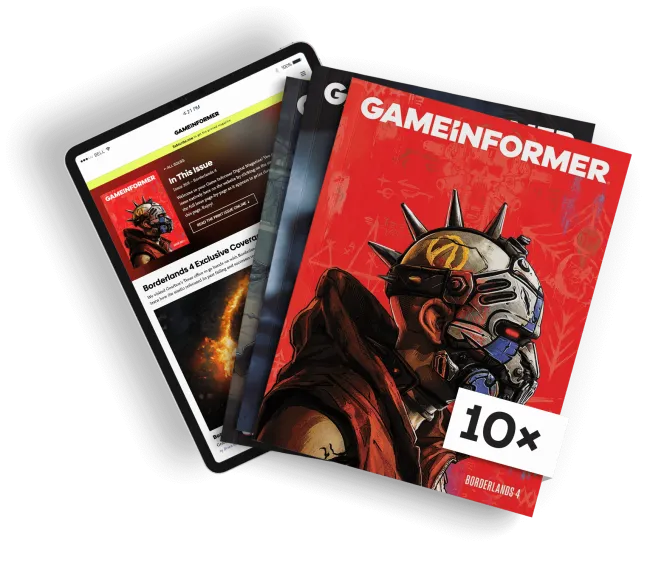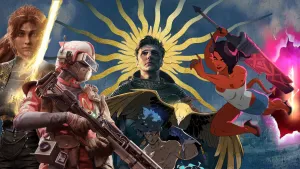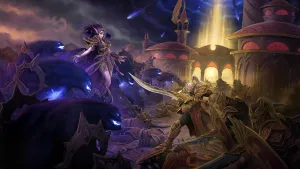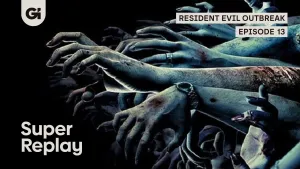The Ties That Divide - Is Game Development A Cooperative Or Competitive Game?

“The
worst part of this business is that publishers think developers are out
to screw them and developers think publishers are out to screw them.”
Paranoia. Power. Money. These are all common themes in game
development. Unfortunately, they take away from everyone’s primary
goal: making a good game. Game Informer talked to people on both sides
of the equation?– some who could only do so anonymously?– to shed light
on the behind-the-scenes battles that go on in game development between
publishers and developers, and to discuss how this traditionally
at-odds relationship can be fixed for the betterment of the games that
we play.
On the face of it, the relationship between
developers and publishers is simple: Publishers give developers an
advance payment and the promise of back-end royalties to create a game,
with payments doled out at agreed-upon milestones as the project
progresses. These milestones, which vary in length, could involve
anything from demonstrating how an in-game feature might work (even if
it lacks any AI, art, etc.) to providing a playable preview build for a
press demonstration.
In practice, while milestones are important
in guiding development, mapping out years’ worth of work is a fool’s
errand. “I’ve never worked on a project where from the beginning to the
end, we knew what the product was we wanted, and at the end sat back
and said, ‘That’s exactly the product we started to create,’” says
producer on the publisher’s side Pete Wanat. Not only are features
being added and dropped, but technology is changing and a host of
problems can derail the project from day to day. Unfortunately, s---
happens?– and that’s also the moment it hits the fan, because if you
don’t deliver on a milestone you don’t get paid.
Developers’
need for cash from publishers puts them in desperate situations. It can
cause them to sell off the rights of the intellectual property they’ve
created to the publisher, accept bad royalty rates, or be bought out by
publishers (where autonomy is exchanged for survival). Often, financial
demands create a situation ripe for bad choices. Multiple develop-ers
told us that studios often take projects that they know they can’t
finish simply to get money from a publisher. They gamble that the
publisher will give them more time?– even if the publisher doesn’t like
the game?– because of the money already invested. This only leads to
bad games and mistrust.
Developers’
monetary demands also lead to bad competition between developers, since
publishers often look for a studio to make a game that fills a certain
need in the publishers’ portfolio. In this case, external developers
might have to outbid each other for a project?– one which they might
know they can’t fulfill to expectation?– and as the fee for work gets
lower and lower, so does the promise of quality. One anonymous
developer we talked to thinks that under certain circum-stances
made-to-order titles are bad for the industry. “There is a little
secret society in every publisher that says, ‘Here is a game we’re
going to do. We’re trying to hit a marketing window, and we don’t care
how bad it is. We’re just trying to sell to those people.’ I believe
that these destroy our industry.”
Money is the root of all evil.
Said one developer, “Someone once told me the Golden Rule really is,
‘The guy with the gold makes the rules.’” Scott Miller, 3D Realms
co-founder, states it just as plainly. “The dirty secret is: Publishers
con-trol developers through payments. Rockstar was paying Human Head so
late on the milestones payments [in the early days of Prey] that 3D
Realms was jumping in to help Human Head because they had payroll to
meet. [Rockstar] even said to us, ‘[You’re] taking over the control
[we] have over developers.’ Nasty stuff like that happens all the
time.” For its part, 3D Realms is helping its fellow developers by
offering creative and financial assistance on projects.
Naturally,
the money that publishers pour into a project entitles them to have
some say. These suggestions can run the gamut of good, bad, and ugly.
“When Prey was being developed early on it was actually a
Rockstar-label game,” ex-plains Miller. “At the time, Metroid Prime was
going to be released, and they had the whole visor thing, and this
pro-ducer [from Rockstar] said, ‘Well, the visor is going to be a big
thing for Metroid, and we should have a visor for Prey.’ And it didn’t
fit anything to do with the game at all. So it ended up where we were
rejecting all these crazy ideas, and for that reason along with some
others, Rockstar ended up dropping the game because we were too hard to
work with.”
The headaches that developers have to put up with
involving money, creativity, control, and time, the publishers have in
the form of risking millions and millions of dollars. While we’ve
illustrated how developers can be hamstrung by the milestone process,
this common form of development doesn’t help publishers either. They
have to commit a large sum of money up front to a project that everyone
knows might not be any good, has too short a schedule to being with, or
could change substantially by the time it releases. It’s like paying
several million dollars for a single lottery ticket.
Sometimes
publishers’ fears are wholly justified. Wanat told us a horror story?–
which he says happens all the time?– of a developer who took the money
from a publisher for a project. Unfortunately, little progress was
being made on it. Suspicious, Wanat investigated and discovered that
the developer was letting his game idle while it was using the
pub-lisher’s money to fund a secret project it was working on all
along. It wasn’t until Wanat sent out an associate producer to
literally oversee day-to-day operations (through a series of surprise
visits) that work was completed on Wanat’s project.
At this
year’s GDC Burning Mad rant session, Lee Jacobson, vice president of
business acquisitions at Midway Games, told the crowd of developers
some of his own experiences. One tale involved a studio head that kept
$300,000 in mile-stone money for himself and then told his own
employees that Midway never sent it. Jacobson also told a story of a
visit to a developer who said it had devoted two teams to his project.
Jacobson met the first team and then went to lunch. When he came back
to meet the second one, he realized that it was made up of a bunch of
members from the first team who were pretending to be different people
by wearing different clothes.
Publishers’ worries about
developers are reflective of their need to focus on the bottom line.
Plenty of publishers are pub-licly traded companies, and are therefore
beholden to the people who own their stock?– people who demand
consistent profit growth. The vicious circle of needing to sell more
and more copies?– not only to pay back the initial advance the
developer was given, but to placate shareholders?– is strong. Mike
Wilson, CEO of publisher Gamecock, says it’s a never-ending trap. “They
have to perpetually show growing profits to their shareholders, and to
do that they have to sell more games. No amount of profit will ever be
enough.”
The pressure of meeting a release date?– right or
wrong?– leads everyone to some very unfortunate situations. If it’s a
movie-based game, you can’t miss the film’s launch, and there’s also
more than just the development schedule to worry about. “Nobody ever
wants to push out a release date,” says Wanat. “People get pissed. You
are not making a game in a vacuum.” Publishers’ strengths are providing
marketing, sales, PR, and distribution/retail support for developers,
and these usually start working on the behalf of a title a year out.
Wanat says delays at this stage are “somewhat” acceptable, but when it
happens six or three months out, that’s when a serious ripple effect
occurs that places the work the publisher puts in at risk.
While
every game would benefit from shipping only when it’s ready, there are
times when push comes to shove and the game gets hurried out the door.
Titles that are sent out prematurely or are running late often skimp on
bug-testing and other quality assurance practices that occur later in
development. “The money people are like, ‘[Quality Assurance] doesn’t
make us any money,’” explains one producer. “‘Shipping this game and
selling it to people makes us money. [Developers] being happy after the
fact doesn’t make us money.’” Many developers told us this stage is
crucial because it’s when a game comes together and gets polish?– which
often separates the good titles from the bad.
One developer we
spoke to said they once had to intentionally sabotage their own product
as it was about to be released to gain valuable Q.A. time. The title
had major problems, but the publisher didn’t care. Knowing that the
game was about to ship out to stores and that there was no time for a
proper fix, the developer submitted the final version of the title and
inserted a game-halting bug that forced the publisher to give the
developer more time to solve the original issues.
One of the
keys to solving these fundamental development problems and creating an
environment between publisher and developer that is less acrimonious
and conducive to great games is thankfully simple: communication.
Communication replaces fear and paranoia with understanding, trust, and
respect. To a person, the developers we talked to felt that the more
both sides knew about the other the better. Liquid Entertainment’s Ed
Del Castillo says that the situation is improv-ing as more people from
the development side go over to publishing, allowing a better
understanding of what goes on. “I wish there was a publisher/developer
exchange program,” he told us. “The guys at Codemasters were in
development be-fore. They get it.”
Better communication can make
stressful situations like the milestone process a little easier. It
allows developers to be more honest about deadlines and the ability to
become more creative with their ideas because the publisher trusts the
de-veloper’s vision, has a better understanding of how to achieve it,
and is more flexible in how to make it happen. On the flip side,
developers would understand the business realities the publisher faces.
A closer relationship like this already exists between good publishers
and developers, as well as between publishers and their internal
studios, where the pub-lisher isn’t treated as just a bank, but a
partner.
Part of this communication has to include working with
the publisher’s marketing department as soon as possible. In this way,
a developer can sell the marketing professionals their vision of the
game so they can turn around and sell it to oth-ers. “A lot of people
are like, ‘We need to hide from big, bad marketing.’ Bulls---.
Marketing’s a part of the process. Rope them in early if you want them
to be great,” observes Wanat.
Gamecock’s Mike Wilson is in total
agreement. “A marketing department should be just slightly behind the
developer itself in knowing where the game is at and where it’s headed.
The simplest idea of just playing the game often times just never
happens.” Marketing can also prevent a developer from getting tunnel
vision on an expendable feature, for exam-ple.
Developer
Clinton Keith is a proponent of an iterative game development method
known as “Scrum,” which, in his opin-ion, fosters better communication
and changes the typical development cycle entirely. Scrum focuses on
creating play-able, full-featured game releases from the beginning.
This is in contrast to traditional development, where all the moving
parts aren’t interacting with each other until near the end. Scrum
allows publishers to see a more fleshed-out version of a game earlier
(and thus mitigate risk), and offers flexibility to a developer.
Instead of trying to decide what a game is on paper at the beginning of
the cycle and adhering to that throughout development, Scrum aims to
let the game itself show where it needs to go.
Keith says that
Scrum is a revolution that actually occurred a long time ago?– with
Nintendo. “I’ve worked first-party with Nintendo, and they refuse to
read anything you send them. We worked with Miyamoto at Angel Studios,
and he would just show up once every three months and look over your
shoulder and give you a couple poorly pronounced Eng-lish sentences,
but it was really pure wisdom. Basically, they’d pay you for another
three months and then go away. A lot of times, he’d say, ‘Find the
fun.’ And so, that kind of became our motto.”
Why doesn’t
everyone use Scrum? Like any process, it’s simply not for everyone.
Ironically, failure is a huge part of the method, because if you can’t
execute it, Keith says you’ll find out right away. First of all, it’s
better to find out your game’s not fun early on and not a couple months
before its release. “By failing fast on an idea you can preserve the
rela-tionship [with a publisher] rather than someone being upset about
losing eight million dollars. Maybe half a million dol-lars was spent
with a small team prototyping an idea and proving themselves, and they
can go onto a different idea, pre-serve the relationship and not lose
that much money.”
Of course, if a developer didn’t have to rely
on a publisher’s money in the first place, then many of their problems
would solve themselves. Developers could take their time making a game
since milestones wouldn’t be as important. BioWare and Pandemic used
cash from venture capitalists Elevation Partners to fuse into one big
super studio, while Brash Enter-tainment is entering the industry with
capital from equity firms (see page 16 for more). There doesn’t seem to
be any one golden road to financial independence, but right now there
is a lot of outside money trying to find its way into the game industry.
Another
possible route is to change the advance-against-royalties model. With
more evenly dispersed payments, devel-opers wouldn’t have to worry
about not getting money after a project ships because there are no
royalties?– which is al-ready common, as many games don’t turn a profit
as it is. Not having to worry about there being no light at the end of
the tunnel creates incentive for studios, stability, and less of a
feast-or-famine situation.
Method Games’ Michael John, who was
the lead design on PSP’s Daxter (working with Ready at Dawn) says that
change can also happen on the individual level. John advocates that
more developers become free agents like him, selling their experience
and skills to studios on a project-to-project basis. This would mean
that studios wouldn’t have to spend their money reserves to retain
valued employees between projects when the publisher milestone money is
not coming in.
With studios being able to operate on lower
overhead costs at the beginning of a project (adding free agents as
they need), publishers won’t have to risk such an initial investment to
jumpstart a project. “People say, ‘Publishers never take risks,’
explains John. “Well, you know what? That’s because you’re giving them
a really, really bad bet.” For their part, individual developers like
John can pick and choose the projects they want to work on and avoid
the office politics. John has already signed on for God of War: Chains
of Olympus for the PSP.
The future of game development has to
look different than it does today. In fact, major change is already
happening. Pub-lishers and developers are refining their methods to
remove the pitfalls and paranoia of the process and trying to ensure
that the games we play are fun. And as Wanat succinctly puts it,
“That’s the only litmus test that I give a s--- about.”
That Joke Isn't Funny Anymore
Licenses
are the great four-letter-word of video games. They often create rushed
development schedules (to coincide with a movie’s release, for
example), which cause them to be bad. Industry insiders tell us that
with movie licenses in particu-lar, good sales don’t even correlate
with a good game, they simply mean that people like the movie. However,
with more collaboration between developers and filmmakers from the
start of a project, and as respect for video games increases licensed
games are slowly improving.
Publishers
making creative demands on developers is such a fact of life that not
one person in the industry we talked to even disputed it. The question
becomes: What is good advice and what is bad advice. Producer Pete
Wanat says “it’s good to want things,” but it’s up to him to take a
stand. “No. No matter how bad you want a mine cart rail level, we’re
not going to put it in.” On the other hand, developers have to rely on
a publisher’s strength?– its marketing depart-ment?– not to jump off
into the deep end and put time and effort into features that aren’t
important.
The
current money-for-milestones structure has some developers living check
to check, but this way of doing business isn’t good for the publisher,
either. “People need constant reality checks to see if a relationship
is working or not,” says Liquid Entertainment’s Ed del Castillo.
“Sometimes you have unscrupulous developers who will take advantage of
a situation and under deliver again and again.” Whether it’s a
developer taking an advance and literally running away with it or a
publisher not being able to see the woods for the trees and causing a
studio to work on a schedule that’s too short, more developer financial
stability eases the milestone structure for everyone’s benefit.

Get the Game Informer Print Edition!
Explore your favorite games in premium print format, delivered to your door.
- 10 issues per year
- Only $4.80 per issue
- Full digital magazine archive access
- Since 1991









